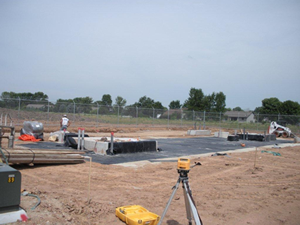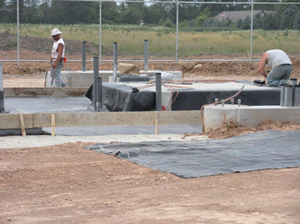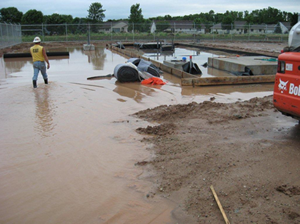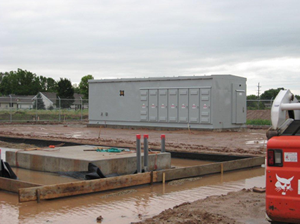 |
Geosynthetics have been invented to solve problems in civil engineering and to provide solutions. The construction industry is highly competitive therefore using geosynthetics can often save costs on a project. A simple example is the use of geotextiles in road construction where the geotextile is used as a separator between the soils and the aggregate. This saves money on aggregate as the stone will sink and be lost in the soils, therefore less aggregate is used.
However, there are cases where businesses are not aware of how geosynthetics should be used and will offer the wrong solution. By offering the wrong solution more damage is caused that will affect the performance of the geosynthetic.
A company is offering a cheap solution for oil containment in the Electrical Industry. As the electrical industry sees secondary oil containment as an expense which they do not have any return they are often buying into this cheap solution.
They are offering a Geosynthetic Clay Liner [GCL] which would be deployed around the transformer pad. Typically the GCL is deployed on the surface of the soils and 4 to 6 inches of stone is placed on top of the GCL. The problem with this is one that 4 to 6 inches of stone will not give the GCL enough confining stress to become a hydraulic barrier. Typically GCL’s are buried under at least 3 feet of soil. Three feet of soil typically equates to a confining stress of 2 psi. This is the confining stress that all GCLs are tested at to assure their performance as a barrier.
 |
Also at 4″ to 6″ of cover stone above the GCL the GCL will not remain hydrated. The GCL will go through periods of hydration and dehydration. It is a well known fact that should the GCL go through periods of hydration and dehydration that the sodium bentonite that is within the GCL will undertake an ionic exchange and become calcium bentonite. Calcium bentonite does not have the high swelling characteristics that sodium bentonite has. So as the clay desiccates through periods of hydration and dehydration, these will not heal and the GCL is no longer a barrier.
We were asked to quote on a utility’s new substation in Wisconsin. On examination of the subsoil we noted that the soils were of fat clays, which would not accept infiltration of water. It was our solution that underneath our system we would put in drainage to move the water from the containment system that we had proposed.
The following is a solution that the client had chosen due to cost. The system was extremely cheap in comparison to the system which we offered.
On the surface of the soil, which was deemed already to be impermeable, a GCL was laid. The GCL was then to be covered with 6″ of stone. See Photo 1.
 |
From this design we can immediately see the first practice of deployment that is incorrect. GCLs when they have a confining stress of 2psi [3 feet of cover soil] or less should be overlapped and loose bentonite augmented in-between the seams. The purpose of this is to assure that there would be no leakage from the seams. There has been no overlapping of the seams in the deployment of the GCLs.
Around the perimeter of this containment area you will note that there is a wooden border. This wooden border is meant to hold in place, until the area is filled with stone a mat which contains co-polymer. In construction of containment systems in is normally not a practice to have a vertical wall of a geotextile. This vertical wall will not remain vertical as frost heaves rain and snow melt will move the vertical fabric. I always use the example of a farmer’s field after winter where rocks which were not apparent in the fall, are now on the surface. This is due to the ground heaving after frost. As this fabric is not attached to anything this fabric will not remain in a vertical position.
It is common practice when forming a wall with geosynthetics that the wall is sloped, typically at a minimum of 1:1 and that the geosynthetic is trenched into the soils. This allows the geosynthetic to float with movement of soils.
 |
As we stated early, we had determined that the soils were impermeable and that we needed to install a drainage system to move the water off site.
Photo 3 was taken after a rainstorm.
The cheap system did not take into account that the soils were impermeable.
Also, the GCL which is now deployed has become prematurely hydrated. Due to this factor the GCL should now be replaced, which it was not. Typically, there is not a problem with a GCL that has no confining stress becomes prematurely hydrated. The issue is now that the GCL must fully dry out before any further action is taken. Also when wet there cannot be any traffic on the GCL, as walking on a GCL will extrude the hydrated bentonite.
If the contractor was experienced in the geosynthetic that he was deploying, he would know that once all the water was removed off site that the GCL needed to be replaced. However, the GCL was walked upon and remained on site.
Sadly this cheap system using the wrong geosynthetics in the wrong application and not taking note of the onsite soil conditions is not offering any containment solution to the customer.
Sometimes, doing nothing is better than spending money on a poorly designed system.
We thank Albarrie for sharing this article with Geosynthetica.
"An Example of the Wrong Geosynthetics Deployed" was first published on Albarrie’s SorbWeb™ Plus website, www.sorbwebplus.com. For more information on Albarrie’s geosynthetic technologies and to find company contacts in your region, visit http://albarrie.com/sorbweb/contactus.aspx.











